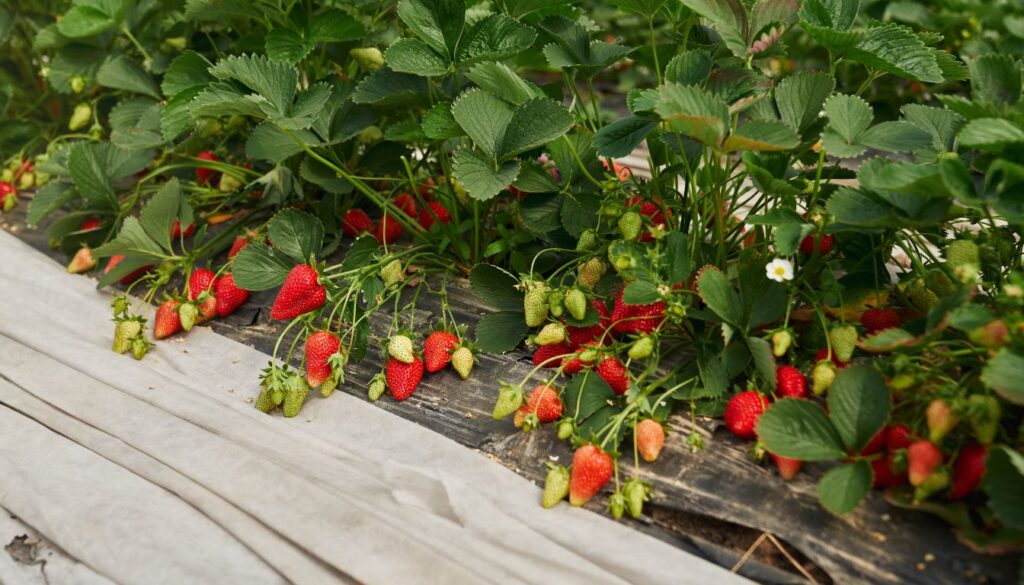There’s nothing quite like biting into a juicy, sun-ripened strawberry fresh from your garden. If you’re dreaming of that sweet experience, growing strawberries in raised beds might just be your best bet. Not only do raised beds offer better drainage and soil quality, but they also make it easier to tend to your plants without straining your back.
Imagine plucking vibrant red berries just steps away from your kitchen, ready to elevate your desserts or morning smoothies. With a little planning and care, you can cultivate a bountiful strawberry patch that will delight your taste buds season after season. Let’s dive into the benefits and best practices for growing strawberries in raised beds, so you can enjoy this delicious fruit right from your backyard.
Benefits Of Growing Strawberries In Raised Beds
Growing strawberries in raised beds offers several advantages. These benefits enhance my gardening experience while ensuring healthy plants.
Improved Drainage – Raised Bed Strawberries: Grow Healthy, Delicious Crops
Raised beds promote excellent drainage. Water flows away easily, preventing root rot. I notice fewer issues with soggy soil, even after heavy rain. Healthy roots thrive in well-drained conditions, leading to better fruit production. Plus, I can grow strawberries in various climates, making it easier to adapt to different weather patterns.
Easier Access For Maintenance
Accessing strawberries in raised beds is a breeze. I can tend to the plants without bending or kneeling, reducing strain on my back. Harvesting ripe strawberries becomes quick and enjoyable. I often find myself picking juicy berries with ease. Weeding also becomes simpler, as I can reach all areas of the bed. Overall, raised beds make maintaining my strawberry patch straightforward and less time-consuming.
Best Varieties For Raised Beds

Choosing the right strawberry variety enhances success in raised bed gardening. Several options excel in raised beds, allowing for a robust harvest.
June-Bearing Varieties – Raised Bed Strawberries: Grow Healthy, Delicious Crops
June-bearing strawberries produce a single, large crop in late spring to early summer. Popular choices include:
- Earliglow: This variety stands out for its sweet flavor and vibrant red color. It’s famous for its abundant yields, making it a favorite among many gardeners.
- Honeoye: With its strong growth habit, Honeoye offers large berries with a pleasing tartness. This variety thrives in raised beds and adapts well to varying climates.
- Kent: Known for its exceptional disease resistance, Kent delivers consistent yields. Its medium-sized berries are perfect for fresh eating and preserves.
June-bearing varieties are ideal for those wanting a concentrated harvest, making summertime delightful.
Ever-Bearing Varieties
Ever-bearing strawberries produce fruit throughout the growing season, from spring to fall. Popular varieties include:
- Quinault: This variety offers a robust harvest and sweet berries. Its ability to produce fruit all season keeps my garden buzzing with activity.
- Ozark Beauty: Known for its large strawberries and vigorous growth, Ozark Beauty is a favorite for continuous harvests. It produces fruit even in cooler temperatures.
- Albion: This variety shines for its flavor and high yield. It also resists diseases, making it a reliable option in raised beds.
Ever-bearing varieties suit my desire for extended harvests, providing fresh strawberries from spring through winter.
Preparing Your Raised Bed
Preparing your raised bed for strawberries sets the stage for a bountiful harvest. Here’s how to get everything ready for those delicious berries.
Choosing The Right Location – Raised Bed Strawberries: Grow Healthy, Delicious Crops
Selecting the right spot for your raised bed is crucial. I look for a location with full sun that gets at least six to eight hours of sunlight daily. Good air circulation keeps plants healthy and helps prevent mold. Avoid low-lying areas that may collect water, as strawberries prefer well-drained soil. Choosing a location that’s close to a water source makes irrigation easier, especially during dry spells. Remember, happy plants make for sweet fruit.
Soil Composition And Preparation
Soil preparation takes a little effort, but it pays off big time. I mix equal parts of high-quality compost, garden soil, and peat moss for a nutrient-rich blend. This combination provides essential nutrients and helps retain moisture. Before planting, I ensure the soil is loose and crumbly. This texture promotes good root growth. I also test the pH level, aiming for a range of 5.5 to 6.8, which suits strawberries best. Don’t forget to incorporate organic matter for an extra boost. Adding a layer of mulch after planting helps retain moisture and suppress weeds, making maintenance a breeze. Remember, healthy soil ensures happy strawberries.
Planting Strawberries

Planting strawberries in raised beds offers a fantastic opportunity for a bountiful harvest. Timing, technique, and care all play crucial roles in ensuring healthy plants and delicious fruits.
Optimal Planting Time – Raised Bed Strawberries: Grow Healthy, Delicious Crops
Spring marks the best time to plant strawberries. I usually aim for late March to early April, once the ground is workable. This timing allows the plants to establish roots before the heat of summer sets in. In warmer areas, fall can also be suitable. Planting in the fall gives strawberries time to establish in cooler weather, leading to vibrant growth in spring.
Planting Techniques
Starting strong leads to success. First, ensure your bed is well-prepared with nutrient-rich soil. When placing strawberry plants, I recommend spacing them about 12 to 18 inches apart. This spacing allows for airflow and prevents overcrowding. Dig a shallow hole for each plant, deep enough to cover the roots but keep the crown above the soil. A plant buried too deep may struggle to grow.
Next, watering becomes essential right after planting. Giving them a good soak helps settle the soil around their roots. I usually water them thoroughly, keeping the soil consistently moist but not soggy. Mulching around the plants prevents weeds and retains moisture, which is always a win in my book! Finally, I enjoy watching my strawberry patch flourish throughout the season, knowing I gave them the best start possible.
Care And Maintenance
Maintaining strawberry plants in raised beds keeps them healthy and productive. Proper care ensures a bountiful harvest of delicious berries.
Watering Requirements – Raised Bed Strawberries: Grow Healthy, Delicious Crops
I water strawberries regularly, making sure to keep the soil consistently moist but not soggy. Deep watering helps roots grow strong. I aim for about an inch of water per week. If rain doesn’t provide enough moisture, I use a soaker hose or drip irrigation to deliver water directly to the roots. Early mornings are the best time to water; this reduces evaporation and disease risk. If leaves start drooping, they’re giving me a subtle hint to hydrate.
Pest And Disease Management
I keep an eye out for pests and diseases, as strawberries can attract unwanted visitors. Aphids, slugs, and spider mites are common foes. I often inspect plants weekly and handpick any pests I find. Beneficial insects, like ladybugs, can also help keep pests at bay, so I welcome them with open arms.
For disease prevention, I ensure good airflow by spacing plants correctly. Mildew can be a problem, so I use mulch to keep soil from splashing onto leaves. If I spot any spots or blights, I remove affected leaves immediately. Regularly rotating crops helps reduce disease buildup in the soil. I cherish my strawberry plants, and a little vigilance goes a long way in keeping them thriving.
Harvesting Strawberries
Harvesting strawberries signals the end of a rewarding journey. It’s time to enjoy the fruits of my labor. Identifying ripe strawberries makes picking easy and efficient.
Signs Of Ripeness – Raised Bed Strawberries: Grow Healthy, Delicious Crops
Look for a bright red color. A ripe strawberry has a rich hue without green or white patches. Check for firmness. Soft berries often mean overripeness. Smell the berries, too; a sweet aroma indicates readiness. If the leaves turn slightly yellow, they might be ready to pick.
Proper Harvesting Techniques
Use gentle hands when picking strawberries. Grasp the stem just above the berry. Twist it gently to detach, ensuring I don’t damage the fruit or plant. Avoid pulling, as this can harm the fruit or roots. Place harvested berries in shallow containers. Stacking can crush them and spoil the harvest. Wash strawberries shortly before eating. They become waterlogged if washed beforehand. Remember, fresh is best; enjoy them as soon as possible for maximum flavor and sweetness.
Before You Go – Raised Bed Strawberries: Grow Healthy, Delicious Crops

Growing strawberries in raised beds has truly transformed my gardening experience. The benefits are undeniable, from improved drainage to easier maintenance. I’ve found that the right variety makes all the difference in achieving a fruitful harvest.
With careful planning and attention to detail, my strawberry patch thrives. The joy of harvesting fresh strawberries is unmatched, and it’s incredibly satisfying to enjoy the fruits of my labor. Whether you’re a seasoned gardener or just starting, I encourage you to try growing strawberries in raised beds. You won’t regret it.
Don’t forget to add theherbprof.com homepage to your favourites so you don’t miss out on future articles.
References – Raised Bed Strawberries: Grow Healthy, Delicious Crops
Little Herb Encyclopedia, by Jack Ritchason; N.D., Woodland Publishing Incorporated, 1995
The Ultimate Healing System, Course Manual, Copyright 1985, Don Lepore
Planetary Herbology, Michael Tierra, C.A., N.D., Lotus Press, 1988
Handbook of Medicinal Herbs, by James A. Duke, Pub. CRP Second Edition 2007
The Complete Medicinal Herbal, by Penelope Ody, Published by Dorling Kindersley
Check the Following Article
Jujube Fruit: Unlocking Nature’s Powerful Health Benefits
Low-Humidity Indoor Plants: Easy-Care and Stylish Options
Butterfly Lily: Amazing Health Benefits to Elevate Well-Being
Evergreen Magnolia: Stunning Year-Round Garden Addition
Frequently Asked Questions – Raised Bed Strawberries: Grow Healthy, Delicious Crops
What are the benefits of growing strawberries in raised beds?
Growing strawberries in raised beds offers improved drainage, better soil quality, and easier maintenance. Raised beds help prevent root rot, promote healthy roots, and yield better fruit production. Additionally, they make it simpler to access plants for harvesting and weeding, minimizing physical strain.
What strawberry varieties are best for raised beds?
Two main types of strawberries are suitable for raised beds: June-bearing and ever-bearing varieties. June-bearing types, like Earliglow and Honeoye, produce a large crop in late spring. Ever-bearing varieties, such as Quinault and Albion, provide fruit throughout the growing season, offering fresh strawberries from spring to fall.
How should I prepare my raised beds for strawberries?
Choosing a sunny location with good air circulation is essential. The ideal soil mix includes high-quality compost, garden soil, and peat moss for nutrients. Ensure the soil is loose and crumbly, with a pH level between 5.5 and 6.8. Adding mulch helps retain moisture and suppress weeds.
When is the best time to plant strawberries in raised beds?
The optimal time to plant strawberries is in spring, ideally from late March to early April. Proper spacing of 12 to 18 inches apart is important for airflow. Water the plants immediately after planting to help settle the soil around their roots.
How do I care for strawberry plants in raised beds?
Maintain consistent moisture without sogginess, watering about an inch per week. Regularly inspect plants for pests like aphids and slugs, while fostering beneficial insects. Ensure good airflow, proper spacing, and practice crop rotation to minimize diseases.
How do I know when to harvest strawberries?
Ripe strawberries are bright red, firm, and emit a sweet aroma. Harvest by gently twisting the stem to detach the berry, and use shallow containers to prevent crushing. Wash strawberries shortly before eating for the best quality and flavor.

